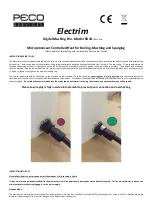
Engine Control System 1A-3
Function and Operation
Electronic Control System
The electronic control system processes the data,
which has been collected with various types of sensors,
by means of the control program installed to ECM
(engine control module) to totally control engine
parameters such as fuel injection quantity, injection
timing, engine startup, altitude compensation, and
EGR.
ECM
ECM Description
The ECM is mounted in the inner part of the engine left
side cover. The ECM monitors various data sent from
diversified sensors and controls systems in the
powertrain. The ECM diagnoses these systems to
detect faults with respect to system operations and
inform the driver of faulty condition via the CHECK
ENGINE lamp (MIL) and stores DTCs (diagnostic
trouble codes). DTC identifies the trouble generation
area to aid repairs by service operators.
Function of ECM
ECM supplies 5 V and 12 V voltages to various sensors
and switches. Since powers are supplied via high
resistances in ECM, Test Light, even when connected
to the circuit, will not be lit. In a special case, a normal
voltmeter does not indicate correct values since the
resistance of the instrument is too low. To get accurate
readings, you need a digital voltmeter whose input
impedance is at least 10 M
Ω
. The special tool 5-8840-
0366-0 is a proper choice for this measurement. In the
ECM, the output circuit is controlled by regulating the
grounding system or power circuit via transistor or
either of the devices listed below.
• Output driver module (ODM)
• Quad drive module (QDM)
ECM and Components
The ECM is designed to offer excellent drivability and
fuel economy while achieving exhaust gas emission
control requirements. The ECM monitors engine and
vehicle functions via various electronic sensors such as
CKP (crank position) and VS (vehicle speed) sensors.
Voltages from ECM
The ECM supplies reference voltages to various
switches and sensors. Resistances of the ECM are
very high and this allows the ECM to supply voltages to
these devices, and voltages actually applied to circuits
are low and even connecting Test Light to individual
circuits may fail turn-on. Since the voltmeter normally
used in service factories has low input impedance,
correct readings may not be obtained. To get accurate
readings, a digital voltmeter whose input impedance is
10 M
Ω
(for example, 5-8840-0366-0) should be used.
Input/output devices of the ECM include analog-to-
digital converter, signal buffer, counter, and special
driver. By using electronic switches, the ECM controls
most system components and turning off a switch
closes the ground circuit. These switches are divided
into four-switch or seven-switch groups, and the former
group is called quad driver module (QDM) and controls
up to four output pins respectively while the latter group
is called output driver module (ODM) and controls up to
seven outputs respectively. Note that all the outputs are
necessarily not used in the control.
Electrically Erasable Programmable ROM
(EEPROM)
EEPROM is a permanent memory chip and soldered to
the board in the ECM. EEPROM stores program and
calibration data, both of which are necessary for the
ECM to control the powertrain. Different from
conventional ROMs, EEPROM cannot be replaced with
new component. If EEPROM fails, the complete ECM
assembly must be replaced with new one.
Precautions on ECM Service
The ECM is designed to withstand ordinary currents
used in operations of a vehicle. Be careful that the
circuits must not be overloaded. To test the ECM to
check open wiring or short, ECM circuits must be
connected to the ground or voltages must not be
applied to the ECM. To test ECM circuits, the digital
voltmeter 5-8840-0366-0 should always be used.
Symbol
Color Symbol
Color
B
Black
BR
Brown
W
White
LG
Light green
R
Red
GR
Gray
G
Green
P
Pink
Y
Yellow
LB
Light blue
L
Blue
V
Violet
O
Orange






































